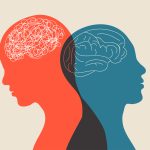When we think of iron deficiency, we often picture fatigue, pale skin, and weakness – classic signs of anemia. However, a groundbreaking new study published in JAMA Network Open sheds light on a less obvious, yet potentially significant, consequence: iron deficiency without anemia can impact brain development and function in young people, particularly in females. …
When we think of iron deficiency, we often picture fatigue, pale skin, and weakness – classic signs of anemia. However, a groundbreaking new study published in JAMA Network Open sheds light on a less obvious, yet potentially significant, consequence: iron deficiency without anemia can impact brain development and function in young people, particularly in females. This research opens up new avenues for understanding and addressing the subtle but crucial role of iron in adolescent mental and cognitive health.
The Unseen Role of Brain Iron
Iron is a vital nutrient, essential for countless bodily functions, from carrying oxygen in our blood to supporting energy production. But its role extends far beyond red blood cells. In the brain, iron is a critical player in neurogenesis (the creation of new brain cells), myelination (the formation of protective sheaths around nerve fibers, crucial for fast communication), and the synthesis of neurotransmitters (chemical messengers that control mood, learning, and more).
Despite its importance, iron deficiency has historically been defined primarily by its impact on blood – specifically, by low hemoglobin levels that characterize anemia. This new study challenged that narrow definition, investigating the effects of iron deficiency (ID) even when red blood cell counts are normal.
A Deep Dive into Adolescent Brains
Researchers from a large network of pediatric clinics conducted a cross-sectional study involving 209 otherwise healthy, unmedicated adolescents aged 10 to 17 years. About 30% of these participants had iron deficiency without anemia, defined by a low serum ferritin concentration (a measure of iron stores) below 15 ng/mL.
The study employed advanced techniques, including brain magnetic resonance imaging (MRI), to peer into the brains of these young participants. They specifically focused on the basal ganglia (BG), a group of brain structures critical for motor control, learning, emotions, and reward processing. The MRI scans measured BG susceptibility (an indicator of iron content) and the volume of BG structures. Participants also underwent clinical interviews to assess psychiatric symptoms and neuropsychological tests to evaluate cognitive performance.
Key Findings: A Clear Link to Brain Health
The results were striking and revealed a significant connection between iron deficiency without anemia and brain health in adolescents:
- Reduced Brain Iron: Adolescents with iron deficiency without anemia showed significantly lower iron content in key basal ganglia regions, specifically the caudate and putamen. This reduction was notable even after accounting for age and sex.
- Sex-Specific Differences: The impact was particularly pronounced in females. As females with iron deficiency without anemia got older, the difference in iron content in their caudate and putamen compared to their non-deficient peers became even larger. This suggests that the developing female brain might be especially vulnerable to the subtle effects of low iron.
- Impact on Brain Structure and Function: Lower iron content in the basal ganglia was inversely associated with the volume of these brain structures and the severity of psychiatric symptoms. Conversely, higher iron content was positively linked to better neuropsychological performance, especially in female adolescents. This indicates that sufficient iron is crucial for healthy brain structure, emotional well-being, and cognitive abilities during this critical developmental period.
What Does This Mean for You and Your Child?
This study offers a crucial new perspective on iron deficiency. It highlights that even without the outward signs of anemia, insufficient iron can have a profound impact on brain development and function in young people. Here’s why this matters:
- Rethinking Iron Deficiency: We may need to broaden our understanding and screening practices for iron deficiency, especially in adolescents. Standard blood tests for anemia might not capture the full picture of iron status.
- Critical Developmental Window: Adolescence is a period of rapid brain growth and maturation. Ensuring adequate iron intake during these years is paramount for optimal neurological development.
- Potential for Intervention: Identifying and addressing iron deficiency without anemia early could potentially mitigate risks for structural and functional brain disruptions, and perhaps even alleviate some psychiatric symptoms or improve cognitive performance.
This cross-sectional study provides valuable insights, suggesting a strong association. Future research will explore these connections further, potentially leading to more targeted interventions and improved health outcomes for young people. If you have concerns about your child’s iron levels or overall development, always consult with a healthcare professional.
What are your thoughts on this hidden link between iron deficiency and brain health?
Fiani D, Kim JW, Hu M, Salas R, Heilbronner S, Powers J, Haque M, Dinh S, Huang X, Worthy D, Devaraj S, Xu J, Calarge C. Iron Deficiency Without Anemia and Reduced Basal Ganglia Iron Content in Youths. JAMA Netw Open. 2025 Jun 2;8(6):e2516687. doi: 10.1001/jamanetworkopen.2025.16687. PMID: 40540272; PMCID: PMC12181794.








